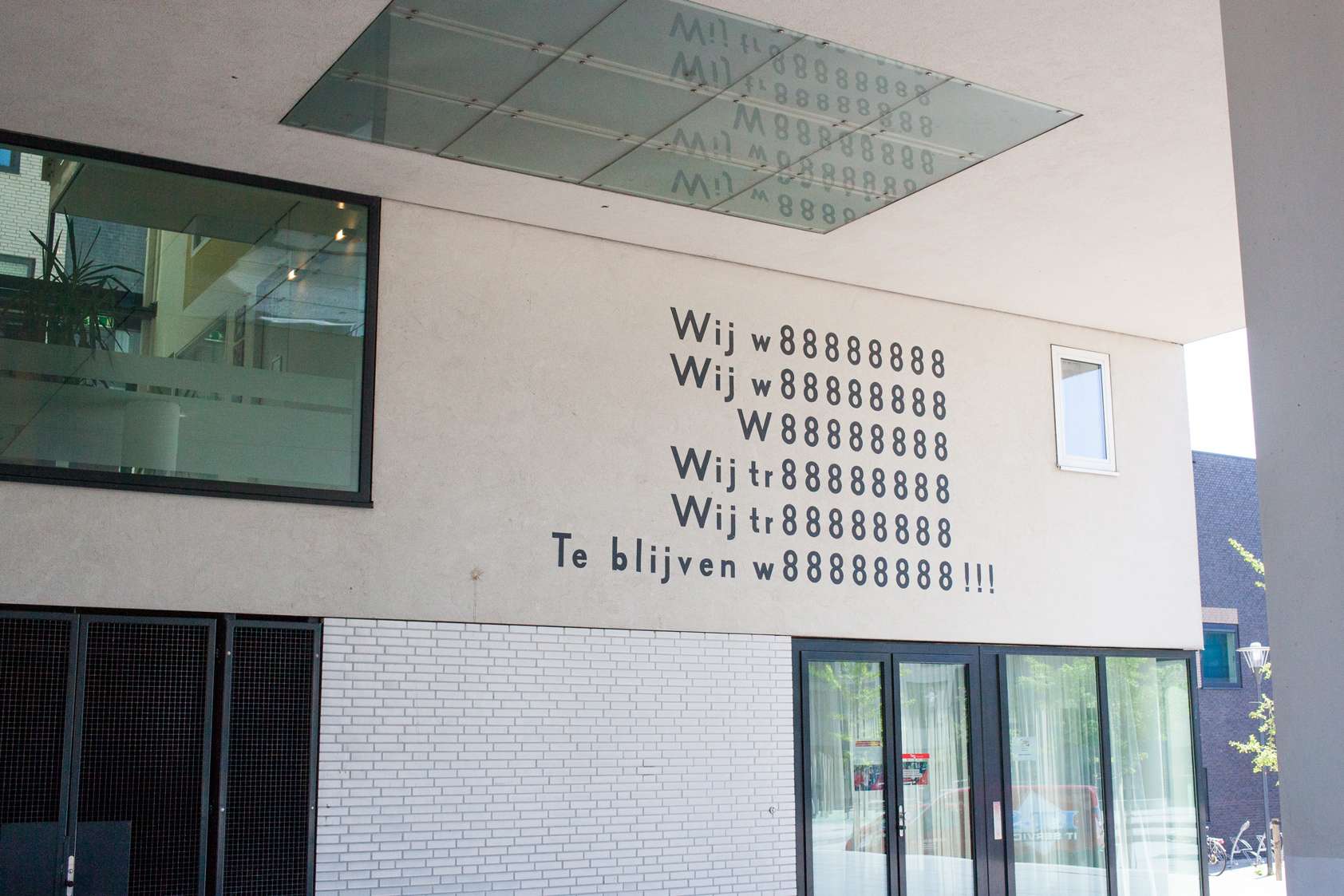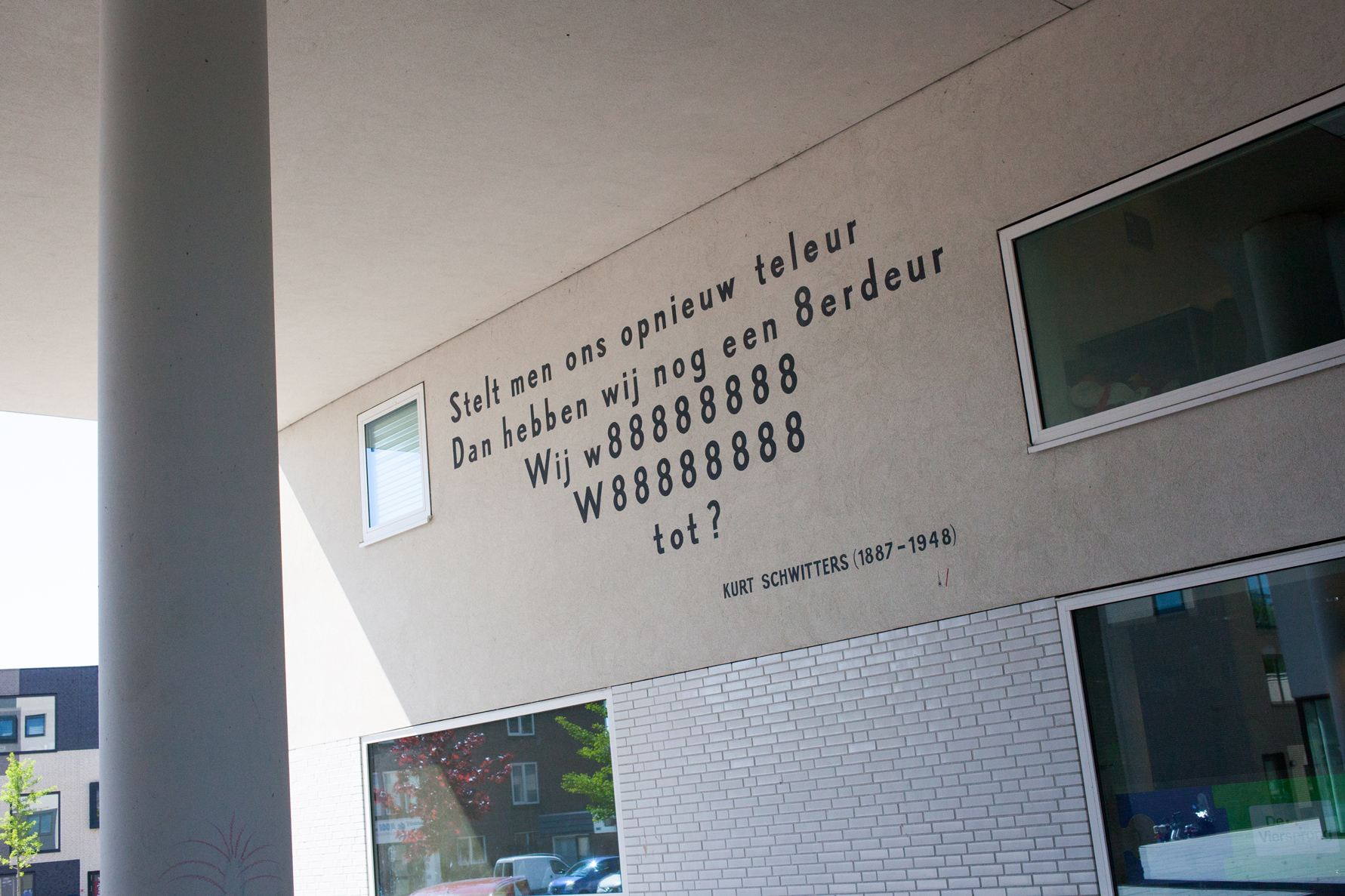Wij w88888888
Wij w88888888
Wij w88888888
W88888888
Wij tr88888888
Wij tr88888888
Te blijven w88888888!!!
Stelt men ons opnieuw teleur
Dan hebben wij nog een 8erdeur
Wij w88888888
W88888888
tot?
Listen to this poem in Dutch.
Voiced by: Leo van Zanen.
This poem in 60 seconds
The Netherlands became acquainted with Dadaism in 1923. Kurt Schwitters, Theo van Doesburg and other Dadaists were on tour and performing in theaters along the way. The experimental art they brought to the stage was constantly scrutinized by the audience, who wondered whether it could be considered ‘real’ art. Their last destination was Drachten, a city in Friesland. When Schwitters arrived in Drachten, the audience had already heard and read about the bizarre performances elsewhere. As for his reputation, it was not necessary to write another poem that would be published in the local newspaper. Fortunately, Schwitters did it anyway and left us this poem.
Want to know more? On this website you can listen to the poem, discover its origins and its author and find out what the poem means to the people of Leiden.
Kurt Schwitters
Hannover 1887 - Kendal 1948
Kurt Schwitters started creating art and writing poetry at a young age. He attended the academy of arts in Dresden and made experimental collages and assemblages from items he found on the streets. In Hannover, people were used to the sight of him rummaging around and picking up (ostensible) trash from the ground. Schwitters is seen as one of the pioneers of the collage.
Merz
Schwitters had a personal style he called ‘Merz,’ which originates from the word ‘Kommerzbank.’ It was very similar to Dada, which - around the same time - caused the whole art scene to be in commotion. Schwitters scoffed at the laws of art, and used everything he could get his hands on for his work. He was an all-round artist who made poems, sculptures, collages and assemblages.
Schwitters in the Netherlands
In 1921, Kurt Schwitters became friends with artist Theo van Doesburg (1883-1931). Van Doesburg brought him into contact with the Rinsema brothers, who owned a cobbler’s workshop in Drachten and also created art. In 1923, Van Doesburg and the Rinsema brothers convinced Schwitters to come to the Netherlands to perform his art. During this period, Schwitters also wrote Wij W88888888.
Refuge and legacy
The Nazis regarded Dada, and therefore also Schwitters’s art, as entartet, meaning degenerate. Schwitters sought refuge in Norway in 1937 and later in the United Kingdom in 1940, where he translated a great part of his work into English. After the war, Schwitters was recognized as one of the greatest German artists of the 20th century.
What’s this poem about?
Since Kurt Schwitters had not yet mastered the Dutch language at the time of the Dada tour, and the Dutch audience generally was not proficient in German, he mainly wrote so-called numerical poems. After all, these could be understood by everyone.
88888888?
The sound ‘achten’ (eights) is represented by the repetition of the number 8. The Dutch sound ‘achten’ is also present in the word Drachten, which is the city where Schwitters would perform. It was also the last performance of the Dada tour that had already caused quite an uproar. Schwitters insinuates in a playful manner that the people of Drachten had been waiting a long time - for him?
Origin story
In 1923, Dada was still an unknown concept to the average Dutchman. This changed when Theo van Doesburg organized a ‘Dada campaign’ with several befriended artists which also came to the Netherlands. The performances took place in The Hague, Haarlem, Amsterdam, Rotterdam, ‘s-Hertogenbosch, Utrecht, Leiden and Drachten, all having a different program and causing a lot of controversy. For the evening in Drachten on 14 April 1923, Schwitters had written Wij W88888888, which appeared in the newspaper as an announcement.
Share your story
Does this poem hold a special place in your heart? For example, do you remember when you first read the poem? Or did you come across it someplace unexpected? Let us know at muurgedichten@taalmuseum.nl! We would love to add your story to our website.
Kurt Schwitters in Leiden

Dit muurgedicht is sinds 2013 in Leiden te vinden op de gevel van Het Gebouw. Het is er aangebracht op initiatief van de architect Ton Venhoeven cs. Zelf bracht Schwitters ook een bezoek aan de stad. Op 14 februari 1923 deed de ‘dada veldtocht’ Leiden aan. Het werd een chaotische avond; bezoekers gingen zelfs met elkaar op de vuist. De schouwburg was voor een kwart gevuld, met vooral studenten en enkele theaterrecensenten. Zij vonden het niks:
“Zo heeft Leiden gisteravond dan ook zijn dollemansavond gehad, want iets anders is het niet geworden,” opende het Leidsch Dagblad de bespreking. “Kurt Schwitters wist een pandemonium te ontketenen, toen hij enkele verzen of wat er voor door moet gaan, geluid voortbrengend voordroeg en daarbij met de ogen dicht een soort krolse kat nabootste. Er werd meegejoeld, meegerateld zelfs, gemiauwd, ja wat niet al.”
Ook de Leidsche Courant kon het niet waarderen. “Zet het publiek iets moois en iets geestigs voor - en het blijft weg. Zeg tot de mensen dat ze allemaal ‘mesjogge’ zijn, draai met een rateltje, zing vals, trommel met je vuisten op een tafeltje, maak gedichten als 1.2.3.4.5.6.7.7.7...7, flap allerlei nonsens eruit, doe gekker dan de gekste gek uit ‘n gekkenhuis.. en de mensen komen bij massa’s.”

Foto's Anoesjka Minnaard
This wall poem can be found in Leiden since 2013. Schwitters also visited the city himself, as the ‘Dada campaign’ arrived in Leiden on 14 February 1923. It became a chaotic evening; visitors even started bashing each other. Only a quarter of the theater was filled and the audience mainly consisted of students and several theater critics. They did not think much of it:
“Leiden had its crazy evening last night, because it wasn’t anything more than that,” stated the Leidsch Dagblad (local newspaper). “Kurt Schwitters was able to unleash a pandemonium when he loudly recited some verses - or something like it - while caterwauling with eyes closed. People were whooping, rattling, meowing, and whatnot.”
The Leidsche Courant (another local newspaper) could not appreciate it either. “Give the audience something beautiful and witty - and they’re nowhere to be found. Say to the people that they are all ‘nuts,’ play with a rattle, sing out of tune, drum on the table with your fists, write poems like 1.2.3.4.5.6.7.7.7...7, talk all kinds of nonsense, act crazier than the craziest madman from the madhouse.. and the turn-out is huge.”
Kurt Schwitters and the Dada movement
The Dada movement was conceived in Zurich in 1916. Here, a group of artists gathered in the Cabaret Voltaire to bring everyday life to the stage. According to Dadaists, everything could be considered art; soon, the boundary between acting and real life faded. Dada was out to provoke, and this also applied to Kurt Schwitters. He stood out with his Ursonate, a sonata consisting merely of ‘primal sounds.’
Dada in the Netherlands
The Netherlands got acquainted with Dada in 1923. The audience’s reaction on the performances changed as the tour progresses. Whereas at the first performance there was still a lot of controversy when Kurt Schwitters made animal sounds during a recitation, the audience began to make animal sounds themselves a few performances later. In Utrecht people even entered the stage and in Leiden a visitor spontaneously joined the performance. Yet Dada remained something for a small group of students and artists in the Netherlands.
Schwitters: a striking appearance
Schwitters must have had a striking appearance during the tour. He did not have much money, which was one of the reasons he always traveled fourth class with two big bags, one on his back and one at his front. In it he had packed his collages which he tried to sell everywhere for 20 marks each. In addition, he also carried cardboard to make new collages (the other materials he found on the streets). He would - as the story goes - always carry a bag of potatoes and a burner to cook, so that he did not have to spend money on food.
Quotes
Now we know what the Dadaists want!
If they have the final word, then each of our old men will receive a scooter to play with in the council chamber. Then all the schoolmasters’ quiffs are dyed green. Then they let the pastors give lessons in candy boxes. The newspaper writers are probably smoked.
Something like that!
They want it crazier than crazy.
The Dragtser Courtant (local newspaper of Drachten) reviewed the Dada evening for which Schwitters wrote this poem
Such a recitation is alternately that of an infant and of a brute. In between he barks very naturally.
The Dragster Courant reviewed the Dada evening for which Schwitters wrote this poem
What is Dada? Kurt Schwitters, the great Dadaist, gave an explanation of the purpose and pursuit of Dadaism at a meeting in The Hague. It was so clear that everyone instantly felt Dadaistic properties glowing within themselves, so that this meeting ended with a Dadaist song, in which cat’s mew, cock’s crow, and frog’s quack formed the melodious melodies.
Leidsch Dagblad, 20 January 1923
Fun facts
- Kurt Schwitters made many ‘sound poems’ such as Wij W88888888. A sound poem is a poem in which sounds play a huge role and the meaning is of no importance. More sound poems can be found in Leiden, such as De mus by Jan Hanlo.
- In 1921, Kurt Schwitters traveled to Saxon in Switzerland together with poet Raoul Hausmann. When they were looking at the view on a mountaintop, Hausmann wrote: “fmswtözäu.” Schwitters published his Ursonate not much later, which is a 35-minute long symphony starting with the sound “fmswtözäu.” This led to a fight between the two. Letters have been found which Hausmann sent 25 years after the publication, in which he asked Schwitters for the acknowledgement of his sound.
- Schwitters greatest works of art, the so-called merzbauten, did not survive the war and the postwar years. Instead, they have almost assumed mythical proportions in art circles. The Moma (Museum of Modern Art) wrote a blog about this and includes several photos.
- Kurt Schwitters lives on in Drachten. Museum Drachten calls itself “Museum Dr8888.” The museum houses a large collection of Dada art.
- Artist Barthel Brussee created a comic of Schwitters’s performance in Leiden called Dada in Leiden.
Wij w88888888
Wij w88888888
Wij w88888888
W88888888
Wij tr88888888
Wij tr88888888
Te blijven w88888888!!!
Stelt men ons opnieuw teleur
Dan hebben wij nog een 8erdeur
Wij w88888888
W88888888
tot?
Learn more
This entry is written by Het Taalmuseum in collaboration with Chris Flinterman. The translation into English is by Rianne Koene. The following publications were consulted:
- Biografie Kurt Schwitters op dadart.com.
- Cardinal, Roger en Gwendolen Webster, Kurt Schwitters (Ostfilden 2011).
- ‘Dada in Drachten’, Trotwaer, 3 (1971), via DBNL.nl.
- Riha, Karl und Jörgen Schäfer, DADA total: Manifeste, Aktionen, Texte, Bilder (Stuttgart 2016).
- Verslagen ‘Dada in Leiden’, Leidsch Dagblad en Leidsche Courant.
